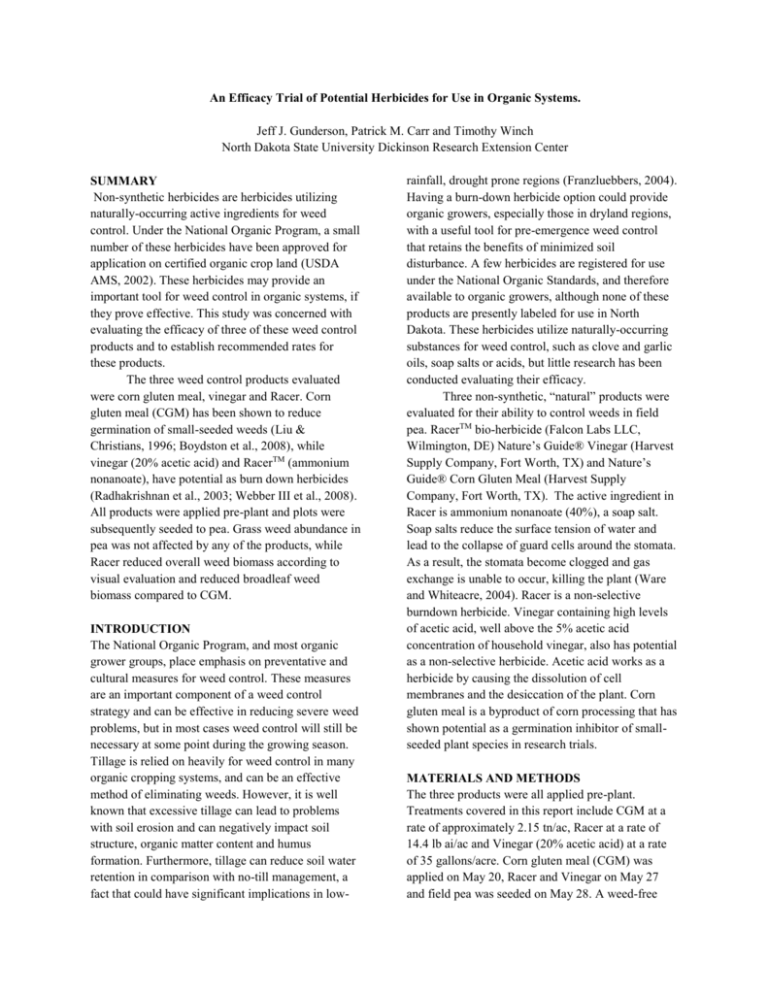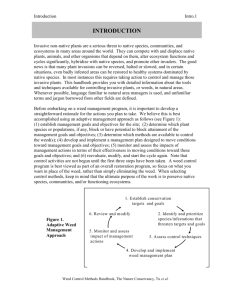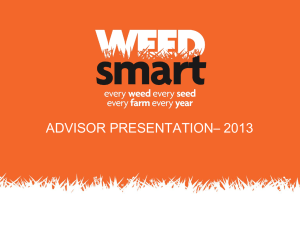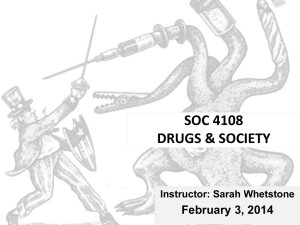An Efficacy Trial of Potential Herbicides for Use in Organic Systems
advertisement

An Efficacy Trial of Potential Herbicides for Use in Organic Systems. Jeff J. Gunderson, Patrick M. Carr and Timothy Winch North Dakota State University Dickinson Research Extension Center SUMMARY Non-synthetic herbicides are herbicides utilizing naturally-occurring active ingredients for weed control. Under the National Organic Program, a small number of these herbicides have been approved for application on certified organic crop land (USDA AMS, 2002). These herbicides may provide an important tool for weed control in organic systems, if they prove effective. This study was concerned with evaluating the efficacy of three of these weed control products and to establish recommended rates for these products. The three weed control products evaluated were corn gluten meal, vinegar and Racer. Corn gluten meal (CGM) has been shown to reduce germination of small-seeded weeds (Liu & Christians, 1996; Boydston et al., 2008), while vinegar (20% acetic acid) and RacerTM (ammonium nonanoate), have potential as burn down herbicides (Radhakrishnan et al., 2003; Webber III et al., 2008). All products were applied pre-plant and plots were subsequently seeded to pea. Grass weed abundance in pea was not affected by any of the products, while Racer reduced overall weed biomass according to visual evaluation and reduced broadleaf weed biomass compared to CGM. INTRODUCTION The National Organic Program, and most organic grower groups, place emphasis on preventative and cultural measures for weed control. These measures are an important component of a weed control strategy and can be effective in reducing severe weed problems, but in most cases weed control will still be necessary at some point during the growing season. Tillage is relied on heavily for weed control in many organic cropping systems, and can be an effective method of eliminating weeds. However, it is well known that excessive tillage can lead to problems with soil erosion and can negatively impact soil structure, organic matter content and humus formation. Furthermore, tillage can reduce soil water retention in comparison with no-till management, a fact that could have significant implications in low- rainfall, drought prone regions (Franzluebbers, 2004). Having a burn-down herbicide option could provide organic growers, especially those in dryland regions, with a useful tool for pre-emergence weed control that retains the benefits of minimized soil disturbance. A few herbicides are registered for use under the National Organic Standards, and therefore available to organic growers, although none of these products are presently labeled for use in North Dakota. These herbicides utilize naturally-occurring substances for weed control, such as clove and garlic oils, soap salts or acids, but little research has been conducted evaluating their efficacy. Three non-synthetic, “natural” products were evaluated for their ability to control weeds in field pea. RacerTM bio-herbicide (Falcon Labs LLC, Wilmington, DE) Nature’s Guide® Vinegar (Harvest Supply Company, Fort Worth, TX) and Nature’s Guide® Corn Gluten Meal (Harvest Supply Company, Fort Worth, TX). The active ingredient in Racer is ammonium nonanoate (40%), a soap salt. Soap salts reduce the surface tension of water and lead to the collapse of guard cells around the stomata. As a result, the stomata become clogged and gas exchange is unable to occur, killing the plant (Ware and Whiteacre, 2004). Racer is a non-selective burndown herbicide. Vinegar containing high levels of acetic acid, well above the 5% acetic acid concentration of household vinegar, also has potential as a non-selective herbicide. Acetic acid works as a herbicide by causing the dissolution of cell membranes and the desiccation of the plant. Corn gluten meal is a byproduct of corn processing that has shown potential as a germination inhibitor of smallseeded plant species in research trials. MATERIALS AND METHODS The three products were all applied pre-plant. Treatments covered in this report include CGM at a rate of approximately 2.15 tn/ac, Racer at a rate of 14.4 lb ai/ac and Vinegar (20% acetic acid) at a rate of 35 gallons/acre. Corn gluten meal (CGM) was applied on May 20, Racer and Vinegar on May 27 and field pea was seeded on May 28. A weed-free and a weedy check treatment were included. Weed control was evaluated visually 1, 7, 14 and 21 days after treatment (DAT) and was reported as % control. Crop and weed biomass samples were taken on July 23 in all treatments except the weed free check, in which biomass samples were taken on August 5. weeds (Fig. 1). Racer suppressed broadleaf weed biomass compared with CGM and weedy check plots, but field pea growth was reduced in plots where Racer was applied compared with weed-free (hand-weeded) plots. The reduced pea growth in Racer plots compared with weed-free plots probably reflects greater competition from weeds in the Racer plots, even though no difference in broadleaf weed biomass was detected statistically between the Racer treatment (weed biomass ≈ 793 lb/acre) and the weed-free treatment (weed biomass ≈ 24 lb/ac). We were unable to detect any difference in broadleaf weed growth between plots where vinegar or CGM was applied and plots where no weed control was attempted. Grass weeds were low in abundance and showed to no response to treatment effects. RESULTS Visual assessments indicated a significantly greater overall control of weeds by Racer compared to CGM 1 DAT and compared to CGM and vinegar 7 DAT (Table 1). No significant difference in % control was observed at 14 or 21 DAT. Even though Racer application initially resulted in greater weed control, at most control was only 10.75%, which occurred 1 DAT. Crop and weed biomass sampling indicated that CGM produced the least control of broadleaf Table 1. Mean % weed control by three non-synthetic products based on visual assessment up to 3 weeks after treatment. Product Rate 1 DAT 7 DAT 14 DAT 21 DAT –––––––– % Control –––––––– CGM 2.15 tn/ac 0.00 1.00 0.00 0.00 Racer 14.4 lb ai/ac 10.75 4.50 3.75 2.50 Vinegar 35 gal/ac 5.25 0.00 0.00 0.00 7.38 1.55 NS NS 0.0359 0.0001 0.1757 0.4393 LSD α=0.05 P 2500 a lb/ac 2000 a 1500 1000 ab Broadleaf Weed bc A 500 B Pea Grass Weed BC c BC C 0 Weed-Free Racer CGM Vinegar Weedy-Check Figure 1. Average weed and crop biomass at harvest as affected by potential organic herbicides. Different uppercase letters denote significant between treatment differences in field pea biomass. Different lowercase letters denote significant between treatment differences in broadleaf weed biomass. LITERATURE CITED Boydston, R.A., H.P Collins and S.F. Vautghn. 2008. Response of weeds and ornamental plants to potting soil amended with dried distillers grains. Hort. Sci. 43(3): 800-803. Franzluebbers, A.J. 2004. Tillage and residue management effects on soil organic matter. In F. Magdoff and R.R. Weil (ed.) Soil Organic Matter in Sustainable Agriculture. CRC Press. Boca Raton, FL. Liu, D. L.-Y., & N.E. Christians, 1996. Isolation and identification of root-inhibiting compounds from corn gluten hydrolysate. J. Plant Growth Regul. 13:227-230. Radhakrishnan, J., J.R. Teasdale and C.B. Coffman. 2003. Agricultural Applications of Vinegar [abstract]. Proc. Northeast. Weed Sci. Soc. 57:63-64. United States Department of Agriculture, Agricultural Marketing Service. National Organic Plan website. National List of Allowed and Prohibited Substances. www.ams.usda.gov/ AMSv1.0/getfile?dDocName=STELPRDC5068 682&acct=nopgeninfo. Accessed 2/25/09. Ware, G.W. and D.M. Whiteacre. 2004. The Pesticide Book, 4th ed. Meister Media. Willoughby, OH. Webber III, C.L., L.P. Brandenberger, J.W. Shrefler, L.K. Wells and K. Shannon. 2008. Ammonium pelargonate/nonanoate as a potential organic herbicide [abstract]. Proc. South. Weed Sci. Soc. 61:136.







